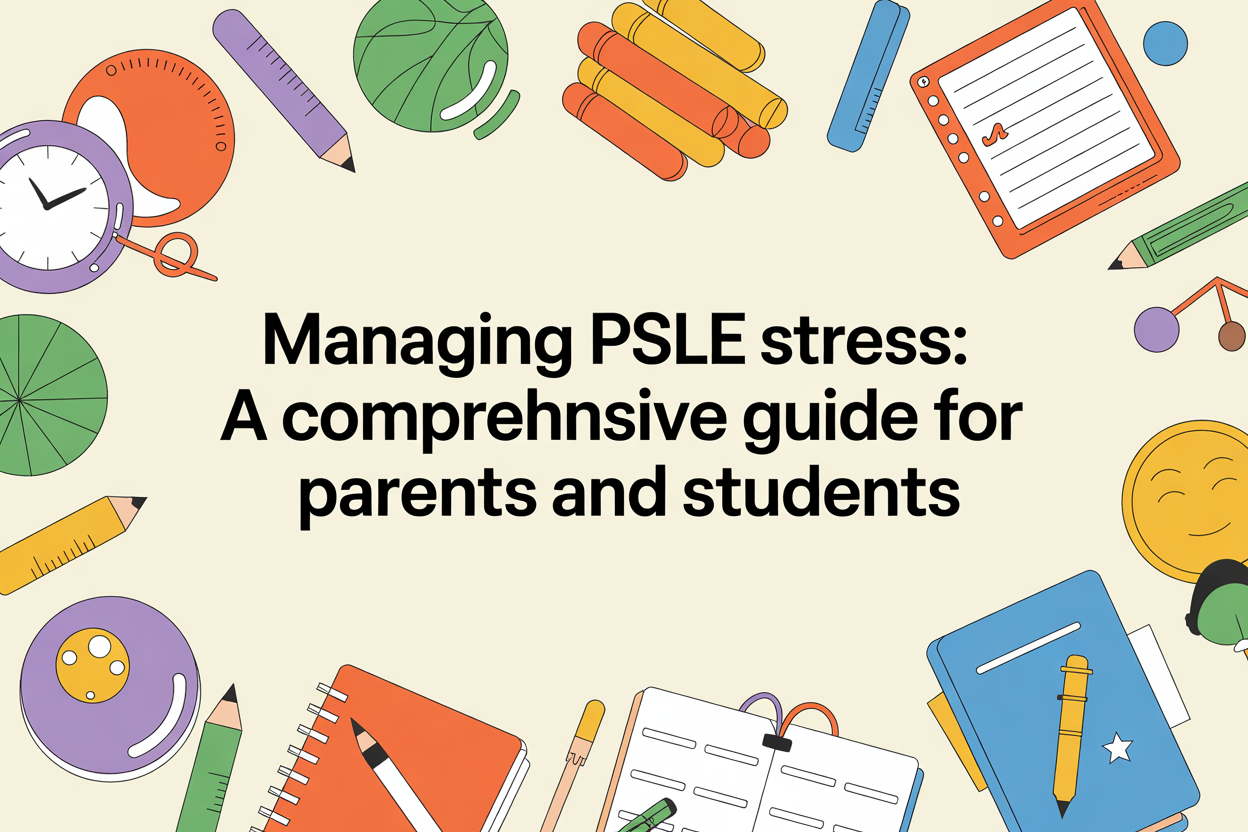- May 18, 2025 -
Building Vocabulary for PSLE Success: Essential Strategies for Singapore Students

Table of Contents
- Why Strong Vocabulary is Critical for PSLE Success
- Understanding PSLE Vocabulary Requirements
- Effective Strategies for Building Vocabulary
- Age-Appropriate Vocabulary Building Techniques
- Incorporating Vocabulary Learning into Daily Life
- Tackling Advanced Vocabulary Concepts
- Common Vocabulary Pitfalls in PSLE and How to Avoid Them
- Measuring and Tracking Vocabulary Progress
- How EduFirst Helps Students Build Strong Vocabulary
Building Vocabulary for PSLE Success: Essential Strategies for Singapore Students
A robust vocabulary is one of the most powerful tools a student can possess when facing the Primary School Leaving Examination (PSLE). Beyond simply knowing more words, a strong vocabulary empowers students to comprehend complex texts, express ideas with precision in compositions, and communicate confidently during oral examinations. For many students, however, vocabulary building remains a challenging aspect of PSLE preparation, often approached through rote memorization rather than meaningful learning.
At EduFirst Learning Centre, we’ve observed that students who excel in PSLE English consistently demonstrate vocabulary mastery that extends beyond memorized word lists. They understand nuances, context-appropriate usage, and can deploy precise vocabulary across different examination components. The good news is that vocabulary building can be systematic, enjoyable, and extremely effective when approached correctly.
This comprehensive guide explores proven strategies to build vocabulary for PSLE success, practical techniques suitable for different primary levels, and methods to track progress while avoiding common pitfalls. Whether your child is just beginning their PSLE journey or making final preparations, these approaches will strengthen their vocabulary foundation.
Why Strong Vocabulary is Critical for PSLE Success
Vocabulary knowledge impacts virtually every aspect of the PSLE English examination. In Paper 1, students with stronger vocabulary craft more sophisticated compositions with precise word choices that engage readers and demonstrate language mastery. Rather than relying on simple, repetitive words, these students can describe scenes vividly, convey emotions accurately, and develop nuanced arguments.
For Paper 2 (Language Use and Comprehension), vocabulary depth directly affects a student’s ability to understand passages, interpret questions correctly, and provide precise answers. Unfamiliar words in comprehension passages often become stumbling blocks, potentially causing students to misinterpret entire sections of text. Additionally, vocabulary-specific questions such as Word Meaning, Vocabulary MCQs, and Vocabulary Cloze passages explicitly test a student’s word knowledge.
In the oral examination, students with broader vocabulary express their thoughts more clearly during the Reading Aloud and Stimulus-based Conversation components. This allows them to demonstrate fluency and engage meaningfully with examiners rather than struggling with limited expression.
Perhaps most importantly, vocabulary serves as the foundation for overall language confidence. Students with strong word knowledge approach language tasks with greater assurance, tackle more challenging texts independently, and develop the linguistic flexibility needed for academic success beyond PSLE.
Understanding PSLE Vocabulary Requirements
The PSLE English examination doesn’t explicitly define a required vocabulary list. Instead, it expects students to have developed a grade-appropriate vocabulary through their six years of primary education. This vocabulary should encompass:
Basic everyday vocabulary forms the foundation, but PSLE success requires more sophisticated word knowledge. Students should recognize and understand words for abstract concepts, technical terms across subject areas, descriptive language for precise expression, and contextually appropriate word usage.
The Ministry of Education’s English Language Syllabus emphasizes vocabulary development across three broad categories:
Functional Vocabulary
This includes words for daily communication, instruction following, and basic academic functions. While most students naturally acquire functional vocabulary, PSLE success requires precision in choosing the most appropriate words from this category.
Subject-Area Vocabulary
These are terms specific to different disciplines and topics, including science, mathematics, social studies, and the arts. Comprehension passages often contain subject-specific terminology that students must understand to interpret the text correctly.
Expressive Vocabulary
This category encompasses descriptive words, emotive language, idioms, and figurative expressions that enhance composition writing and demonstrate language sophistication. PSLE markers particularly look for effective use of expressive vocabulary in compositions.
Most challenging for students is not merely recognizing words but understanding their contextual usage, connotations, and appropriateness in different situations. The PSLE tests this deeper level of vocabulary knowledge through comprehension questions, cloze passages, and vocabulary MCQs that require understanding words in context.
Effective Strategies for Building Vocabulary
Vocabulary development works best as a consistent, integrated approach rather than isolated memorization. These research-backed strategies provide a framework for effective vocabulary acquisition:
Wide Reading with Purpose
Reading remains the most powerful vocabulary building tool available. However, passive reading alone isn’t enough. Teach your child to read actively by identifying unfamiliar words, determining meaning from context before checking a dictionary, and maintaining a personal vocabulary journal. At EduFirst, we recommend establishing a daily reading routine of at least 20-30 minutes with materials slightly above a child’s current reading level to introduce new vocabulary naturally.
Ensure varied reading materials including fiction, non-fiction, newspapers, magazines, and online articles. The Straits Times Schools section, National Geographic Kids, and Singapore-published children’s literature provide excellent vocabulary exposure relevant to local contexts.
Vocabulary Journaling
A vocabulary journal transforms passive word encounters into active learning. Rather than creating simple word lists, encourage your child to create detailed entries for each new word, including:
The word and its pronunciation, dictionary definition written in the child’s own words, the sentence where they encountered the word, an original sentence using the word, synonyms and antonyms, and any prefix, suffix or root word identification. This multi-dimensional approach creates stronger mental connections than traditional vocabulary lists.
Review the journal regularly, perhaps turning words into weekly vocabulary quizzes or games. This spaced repetition helps transfer words from short-term to long-term memory.
Context-Based Learning
Words learned in isolation rarely stick. Instead, study vocabulary in meaningful contexts. When learning new words, examine how they function in sentences, their relationship to other words, and their appropriate usage situations. This contextual understanding helps students not just recognize words but use them appropriately in compositions and oral communication.
For PSLE preparation, categorize vocabulary by themes commonly appearing in examinations, such as environment, technology, social issues, or personal challenges. This thematic organization helps students access relevant vocabulary during composition writing or oral discussions.
Word Study Techniques
Understanding word formation principles gives students tools to decode unfamiliar words independently. Teach your child to identify common prefixes (un-, re-, dis-), suffixes (-tion, -ment, -ous), and root words. This morphological awareness allows students to make educated guesses about new words and remember related word families more effectively.
For example, understanding that “bio” relates to life helps connect words like biology, biodiversity, and biosphere. Similarly, recognizing that “con” often means “together” helps understand words like connect, confluence, and congruent.
Age-Appropriate Vocabulary Building Techniques
Vocabulary building strategies should evolve as students progress through primary school. Here’s how to tailor approaches for different stages:
Lower Primary (P1-P2)
During these foundational years, focus on building concrete vocabulary related to children’s immediate experiences. Picture books, word games, and everyday conversations provide excellent learning opportunities. Label objects around the house, discuss words during shared reading, and play simple word association games.
Introduce basic synonyms for common words like “happy,” “sad,” “big,” and “small” to begin developing word variation. Create word walls at home featuring new vocabulary with images to reinforce visual connections. Most importantly, make vocabulary learning playful and interactive rather than formal study.
Middle Primary (P3-P4)
As students begin more formal writing assignments, help them transition from basic to more expressive vocabulary. Introduce word gradation (good, great, excellent, outstanding) and targeted vocabulary for different writing genres. Begin exploring word origins and simple prefix/suffix patterns.
Encourage more independent vocabulary collection through personal dictionaries or vocabulary journals. Introduce board games like Scrabble, Boggle, or Taboo that develop word consciousness while remaining engaging. Vocabulary building should still maintain an element of discovery and fun at this stage while becoming more systematic.
Upper Primary (P5-P6)
PSLE preparation intensifies during these years, requiring more sophisticated vocabulary acquisition strategies. Incorporate past PSLE papers to identify vocabulary gaps and patterns. Focus on precision in word usage rather than merely expanding vocabulary size.
Emphasize contextual understanding by analyzing vocabulary in comprehension passages. Practice replacing basic words in compositions with more precise alternatives. Introduce more systematic study of word families, idiomatic expressions, and phrasal verbs commonly tested in PSLE.
Develop vocabulary around exam-relevant themes like environmental issues, technology, social challenges, personal growth, and community topics. Create specialized word banks for descriptive writing, argumentative writing, and narrative compositions.
Incorporating Vocabulary Learning into Daily Life
Vocabulary development needn’t be limited to formal study sessions. Integrate word learning into everyday activities with these approaches:
Conversation-Based Learning
Quality family conversations offer powerful vocabulary learning opportunities. Use precise language when speaking with your child and casually explain unfamiliar words. Discuss news events, share opinions on books or shows, and encourage your child to articulate their thoughts precisely.
Create a “word of the day” family tradition where everyone attempts to use the selected word throughout the day. This playful approach makes vocabulary practice part of family culture rather than an academic exercise.
Media as Vocabulary Resource
Modern media can significantly enhance vocabulary when consumed thoughtfully. Select educational YouTube channels, documentaries, podcasts, and quality television programming that expose children to rich language. Discuss unfamiliar words encountered in these media.
Audiobooks provide excellent vocabulary exposure, particularly for students who might resist traditional reading. The narration helps with pronunciation while the story context aids comprehension. Consider audiobooks slightly above your child’s reading level to introduce new vocabulary.
Environmental Learning
Singapore’s rich multicultural environment offers countless vocabulary opportunities. Visit museums, nature reserves, cultural neighborhoods, and local exhibitions with vocabulary learning in mind. Before outings, research relevant terminology together, and afterward, discuss new words encountered.
Even grocery shopping can become a vocabulary exercise by discussing food origins, preparation methods, and descriptive words for tastes and textures. These real-world connections strengthen word retention more effectively than isolated memorization.
Tackling Advanced Vocabulary Concepts
As students approach PSLE, several advanced vocabulary concepts require targeted attention:
Idiomatic Expressions
Idioms frequently appear in comprehension passages and add sophistication to compositions. Rather than memorizing extensive idiom lists, focus on commonly used expressions in Singaporean contexts and international English. Study idioms in realistic contexts, understand their meanings and appropriate usage situations.
Create an idiom journal with the expression, its meaning, origin (if interesting), example sentences, and appropriate contexts for use. Practice incorporating these naturally into writing rather than forcing them into compositions artificially.
Phrasal Verbs
Phrasal verbs combine basic verbs with prepositions or adverbs to create new meanings. They appear frequently in PSLE comprehension passages and can be challenging for students who try to interpret them literally. For example, “looking forward to,” “running out of,” and “putting off” have meanings that differ from their component words.
Group phrasal verbs thematically (time-related, movement-related, etc.) and practice identifying them in readings. Creating visual representations or gesture associations can help students remember these combinations more effectively.
Synonyms and Antonyms
PSLE frequently tests synonym and antonym knowledge both explicitly and through vocabulary cloze passages. Beyond memorizing word pairs, students should understand the subtle differences between similar words. For example, “happy,” “content,” “pleased,” and “delighted” have distinct connotations and usage contexts.
Practice precise word choice by creating “word spectrums” that show gradations of meaning. For size, this might include: tiny, small, medium-sized, large, enormous, gigantic. Discuss how choosing the right word from this spectrum adds precision to writing.
Common Vocabulary Pitfalls in PSLE and How to Avoid Them
Based on our experience at EduFirst Learning Centre, we’ve identified several vocabulary-related challenges that frequently impact PSLE performance:
Commonly Confused Words
Words that sound similar (accept/except) or have related meanings (affect/effect) consistently cause problems in PSLE. Create a personal “confusables” list with clear examples distinguishing these pairs. Use mnemonic devices or visual cues to help remember the distinctions.
Other frequently confused word sets include their/there/they’re, loose/lose, principal/principle, and weather/whether. Regular practice with these specific words helps eliminate these common errors.
Overreliance on Memorized Phrases
Many students memorize “good phrases” for composition writing without fully understanding their meanings or appropriate contexts. This often results in awkward usage that markers can easily identify. Instead, focus on understanding fewer phrases thoroughly rather than memorizing extensive lists superficially.
Teach students to evaluate whether a phrase genuinely enhances their writing rather than inserting memorized expressions arbitrarily. Quality of vocabulary usage always trumps quantity in PSLE marking.
Contextual Misunderstanding
In vocabulary cloze passages, students often select words that fit grammatically but ignore the broader context. Teach your child to read entire paragraphs before attempting vocabulary questions, considering tone, purpose, and logical connections between sentences.
Practice vocabulary cloze exercises regularly, focusing not just on correct answers but on explaining why certain words fit the context while others don’t. This develops the analytical thinking needed for PSLE vocabulary sections.
Measuring and Tracking Vocabulary Progress
Effective vocabulary development requires regular monitoring to identify progress and areas needing attention:
Setting Vocabulary Goals
Establish clear, measurable vocabulary objectives appropriate to your child’s level. For younger students, this might involve learning 5-10 new words weekly. Upper primary students might target 10-15 words plus associated synonyms, antonyms, and contexts.
Rather than focusing exclusively on quantity, set quality goals related to vocabulary usage in writing. For example, aim to replace five common words with more precise alternatives in each composition, or correctly use three idioms in appropriate contexts.
Assessment Methods
Regular vocabulary assessment provides motivation and identifies learning gaps. Beyond traditional spelling tests, use methods that assess deeper understanding. Ask students to create sentences demonstrating nuanced word meanings, complete cloze passages, or explain subtle differences between similar words.
Compare vocabulary usage in compositions over time by tracking word variety, precision, and sophistication. Many parents keep a portfolio of their child’s writing throughout primary school to visually demonstrate vocabulary growth.
Recognizing Improvement
Watch for indicators of vocabulary progress beyond test scores. These include: increased confidence in approaching difficult texts, more varied word choices in compositions, greater precision in expressing ideas, improved comprehension scores, and spontaneous interest in word meanings and origins.
Celebrate vocabulary milestones with recognition and small rewards to maintain motivation. This might include completing a vocabulary journal, consistently using new words in conversation, or showing improvement in schoolwork.
How EduFirst Helps Students Build Strong Vocabulary
At EduFirst Learning Centre, vocabulary development forms an integral part of our English curriculum across all primary levels. Our approach differs from conventional methods in several key ways:
Personalized Vocabulary Development
Our small class sizes (limited to 4-8 students) allow teachers to identify each student’s vocabulary strengths and gaps. Unlike generic vocabulary lists, we tailor vocabulary targets to individual needs, addressing specific weaknesses while building on existing knowledge. This personalized approach ensures more efficient learning and better retention.
Through initial and ongoing assessments, we track each student’s vocabulary profile and adjust teaching strategies accordingly. Some students require more contextual learning, while others benefit from structured word study or visual associations.
Integrated Vocabulary Instruction
Rather than teaching vocabulary as an isolated subject, we integrate word learning into all aspects of English instruction. During comprehension exercises, students identify unfamiliar words and discuss their meanings and usage. In composition writing, teachers guide students to select precise vocabulary and refine word choices during editing.
This integrated approach helps students see vocabulary as a practical tool rather than an academic exercise. They develop word consciousness – the habit of noticing and being curious about words – which continues beyond the classroom.
PSLE-Focused Vocabulary Building
Our curriculum specifically targets vocabulary skills assessed in PSLE. Students practice with actual PSLE vocabulary questions, vocabulary cloze passages, and comprehension exercises containing challenging vocabulary. This examination-oriented practice builds familiarity with PSLE vocabulary demands while developing practical language skills.
For upper primary students, we conduct targeted revision of commonly tested vocabulary areas including idioms, phrasal verbs, contextual word usage, and precision in expression. These focused interventions address the specific vocabulary challenges students face in PSLE English.
Conclusion
Building a strong vocabulary for PSLE success requires consistent effort, strategic approaches, and meaningful engagement with words in various contexts. Rather than relying on memorization alone, effective vocabulary development integrates reading, writing, speaking, and listening with explicit word study.
The strategies outlined in this guide provide a comprehensive framework for vocabulary development from lower primary through PSLE preparation. By adapting these approaches to your child’s learning style, interests, and current vocabulary level, you can support their language development journey effectively.
Remember that vocabulary building is a gradual process that compounds over time. Starting early and maintaining consistent practice yields the best results, but it’s never too late to implement more effective vocabulary strategies. Even students in P5 and P6 can significantly improve their vocabulary with focused effort and appropriate techniques.
At EduFirst Learning Centre, we partner with parents to develop students’ vocabulary within our broader English curriculum. Our small-group approach ensures personalized attention to vocabulary needs while our experienced teachers provide structured guidance for PSLE success.
Take the Next Step in Your Child’s PSLE Preparation
Want to learn more about how EduFirst can help your child build strong vocabulary skills for PSLE success? Our experienced teachers are ready to assess your child’s current vocabulary level and develop a personalized learning plan.
Contact us today to schedule a consultation or visit one of our 25 centers islandwide.


